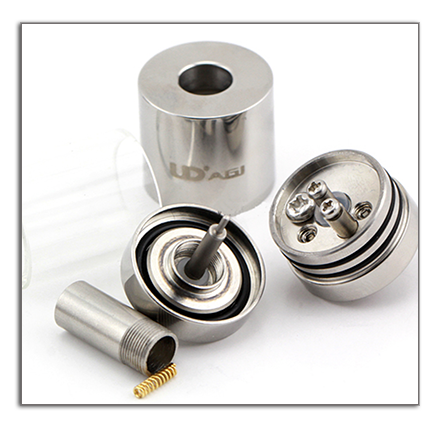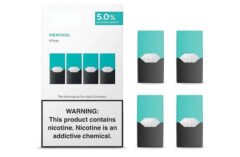Last Updated on August 28, 2018 by
First and foremost, it’s confession time. Before I even start this review I need to get something off my chest. I am not of fan, in the slightest bit of Genesis style rebuildable atomizers. I don’t like working with stainless steel mesh or standard wrapped coils. I don’t like the fact that you can’t lay these type of devices down without them leaking like sieve. With that being said, I was less than enthused when I found out this was the next device I was assigned to review.
Now I know what you’re thinking-“He’s going to give a biased review of this device, simply because he isn’t a fan of the design.” So let me stop you right in your tracks. I pride myself on non-biased, honest reviews and when I say something is good, you can trust me on that. And spoilers- this is a solid device that I have surprisingly enjoyed using over the last couple weeks. First I’m going to dive under the hood and tell you a little more about the device it’s self, how I’ve set it up and the over all pros and cons of it.
The Youde AGI is actually a dual-mode rebuildable atomizer. It can be set up in Genesis mode with the tank or RDA style with just the deck and no tank attached. I spent several days with this device in both modes and let me tell you, it’s great. The Youde AGI is made of 304 stainless steel and the attached tank portion is Pyrex, so you don’t have to worry about which juices you fill this thing up with, it’s fill and go. It is a 22mm device, so it’s going to sit flush on all your mech mods and most other APV’s.
If you’re using it with a ProVape ProVari it’s going to hang over the top ring just a little bit. Not a problem when it comes to performance at all, but it’s not my favorite visual look when pairing a device with an APV. My only concern is the spring that’s used to make contact with the 510-connection between the tank section and the build deck, but more on that later.
When I received the device it came in the standard Youde black box with a few extras inside. Inside a shrink wrapped package with the atomizer were extra o-rings (2), extra fill port screws (2), an extra ground screw, an extra connector spring, a piece of 400 steel mesh and a small strand of 32awg Kanthal resistance wire. So from the get go, you have everything you need to set this device up, if mesh is your preferred way to go.
 At this point, I’d like to talk about the way I vape and the way I prefer to build RBA’s and RDA’s before we get into the thick of this review. I already said I am not a fan of stainless steel mesh; I just don’t like the taste that comes through with the vapor. It always tastes metallic to me, no matter what I do. I’m also not a fan of silica either. Now at this point you’re asking yourself, “What in the world does he wick his RBA/RDA with?” Some time ago I discovered a video on YouTube that detailed wicking a device with organic cotton.
At this point, I’d like to talk about the way I vape and the way I prefer to build RBA’s and RDA’s before we get into the thick of this review. I already said I am not a fan of stainless steel mesh; I just don’t like the taste that comes through with the vapor. It always tastes metallic to me, no matter what I do. I’m also not a fan of silica either. Now at this point you’re asking yourself, “What in the world does he wick his RBA/RDA with?” Some time ago I discovered a video on YouTube that detailed wicking a device with organic cotton.
I tried it and have been hooked ever since. As a matter of fact, all my current devices are wicked with cotton, even my rebuilt Kanger ProTank heads. I prefer the clean flavor cotton produces to any other wicking material. You may have noticed I also said I don’t prefer standard coils earlier as well. You’re probably asking yourself, “What kind of coils does he use?”
In the same video on YouTube about using cotton, it also explained how to build a micro-coil. Ever since building my first one, it’s one of the only types of coil I build anymore. The micro-coil heats up faster than a standard wrapped coil and heats up more evenly as well. This is going to leave with you better flavor and more vapor production when compared to standard wrapped coil.
I also prefer 28awg Kanthal to 32awg kanthal. It’s a bit thicker and easier to work with when wrapping coils and because it’s thicker I can actually wrap those lower ohm coils with 28awg and get them to hold their shape. The coil is more durable this way and lasts quite a bit longer in my experience. When it’s time to re-wick, you just pull the cotton out, dry burn to remove any build up on the coil and thread more cotton through. No more wrapping a new a coil every time you have to re-wick a device. When it comes to micro coils I prefer coils in the 1.1-1.3 ohm range in RBA’s and 0.7-0.8 ohm range in RDA’s and this is exactly how I set this device up in each of it’s operating modes.
As I said earlier, I’m not a fan of Genesis style atomizers, so upon receiving this device, I went on the hunt for alternative builds to try. I found an example of a vertical micro coil and cotton build in a Genesis style atomizer, which sets up in auto-dripping mode.
SPECS: $34.99 – Stratomyst
Capacity: 3ml e-Liquid Air Hole: located on outer casing; adjustable air flow positioning Wicking Hole Size: 3.5mm Height: 52mm Diameter: 22mm Connection: 510, Sealed Battery Connection Weight: 2.83 ozContents: 1 AGI Rebuildable Drip & Tank Atomizer in gift box 1 Spare Parts Kit- including:
- Small piece #400 Stainless Mesh
- Small piece Resistance Wire
- Small piece of Silica Wick
- Three extra O-rings
- Extra Insulator
- Three extra screws
I decided to give this a shot as an alternative to a standard coil/mesh build. I wrapped a 1.2-ohm micro coil and attached it to the ground screw and positive post in the AGI. I twisted my cotton into a wick and threaded it through the coil into the tank section of the device. After a quick fill of my favorite e-liquid I was off and vaping. A quick tilt of the device and the cotton wicks the e-juice surprisingly quick. The basic idea of Genesis style devices still applies here, you need to tilt before you vape to aid in the wicking, but you don’t have to hold the device pointed toward the ceiling the entire time you’re taking a draw. A quick tilt before each draw is more than enough to saturate the cotton so that you’re getting a dry hit.
Vapor production is outstanding with the cotton and micro coil and I fogged out my living room in a short amount of time. The air hole is 1.2mm, which is perfect for mouth-to-lung inhales and the flavor was clean and crisp out of the Pyrex tank. One of my favorite features of this device in Genesis mode was the size of the fill hole and wick hole. They’re quite a bit smaller than I’ve seen on other Genesis style RBA’s, so leakage hasn’t really been an issue. Would I throw it in my pocket with no worries about it leaking? No I wouldn’t. But you don’t have to worry about juice leaking out of the air hole every time you tilt it get it to wick properly. As a whole, it’s changed my mind on Genesis devices and how they perform. I’ve thoroughly enjoyed using it and continue to do so.
Now my favorite way to vape is with an RDA. I prefer drippers to any other of style of device and the AGI is no slouch when you set it up in RDA mode. I built a 0.7-ohm micro coil and wicked it with cotton (imagine that, right?) and was thoroughly impressed with its performance. The AGI has a single positive and negative post, so you’re restricted to single coils builds only, which isn’t an issue for me. While I’ve experimented with dual micro coils, dual Nano coils and dual dragon coils over the past few months, a single micro coil is still my preferred way to vape. It produces a warm, but not overly hot vape. On a mechanical device, 0.7 ohms heats up quite quickly and produces a dense, flavorful vapor. As far as drippers go, I actually prefer the AGI to Youde’s IGO-L when it comes to dripping. I’m using it as we speak and it’s become a favorite device of mine to use on my SMOKTech Magneto.
All in all, this is an excellent device. I’ve thoroughly enjoyed using it as an RBA and an RDA over the past couple of weeks. It produces copious amounts of vapor in either configuration and flavor is crisp and clean. There is a single draw back to this device though. Earlier in this review you may remember I talked about the spring that makes the 510-connection between the tank section and the build deck. Despite it being inside a tube that runs the length of the Pyrex tank and juice never actually touching the spring- it’s already oxidized after only a week of use. This is an issue in my eyes, because that oxidation is causing a voltage drop. With a voltage drop between 0.2 and 0.5 volts, it’s hindering the performance of the device. No you do get an extra spring in the box, so it’s not an issue to swap it out, but that gets you two weeks of good performance. What after that? I’m not sure of a fix for this and I’m going to attempt to clean the spring and see what happens. But if Youde can iron out this one little issue, they’ve got a seriously great device at an amazing price point.
Side note about safety- I’ve talked about low ohm and sub-ohm coil building in this review. Now this is my preferred way to vape, but if you don’t have a multi-meter or ohm checker to check the resistance of your coils, please don’t attempt this. Also, you need the correct batteries to power sub-ohm builds. Sub-ohm coils pull serious amperage out of the battery powering your device and if your battery isn’t rated to handle the amp load there is a chance that it’s going to vent. You can find a chart for some of the more popular batteries on the market and their specific amp ratings. Vape smart and vape safe my friends.
Cameron Skaggs








